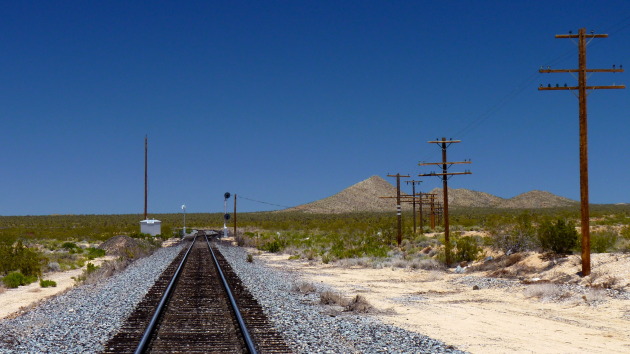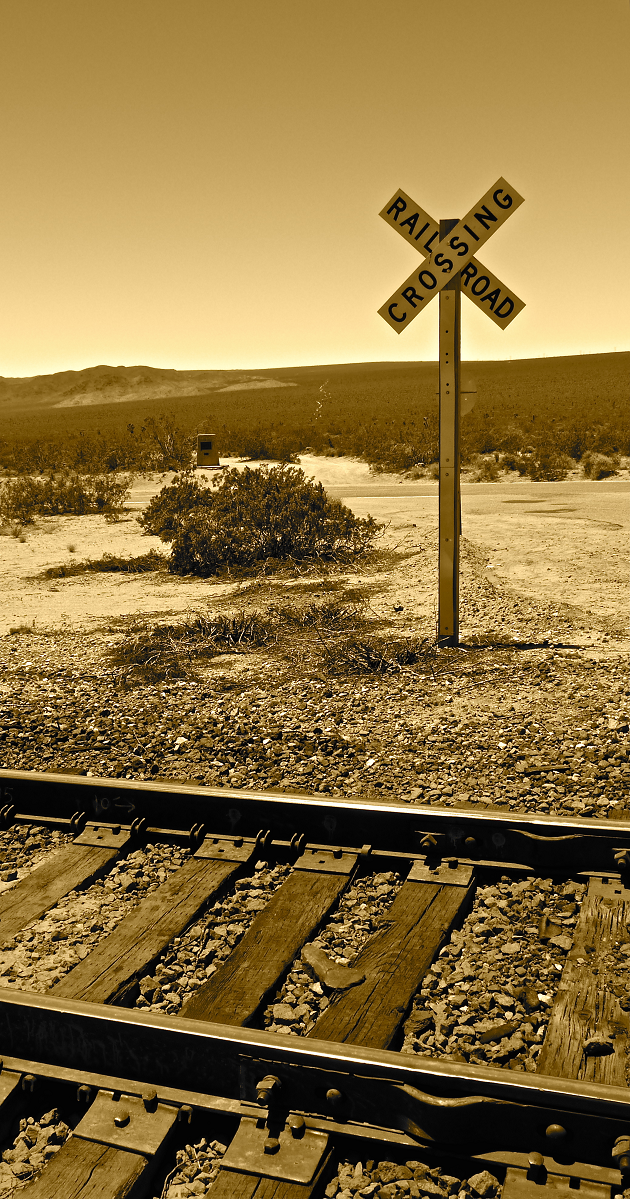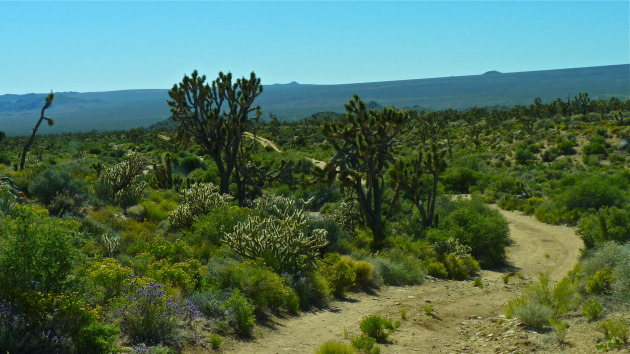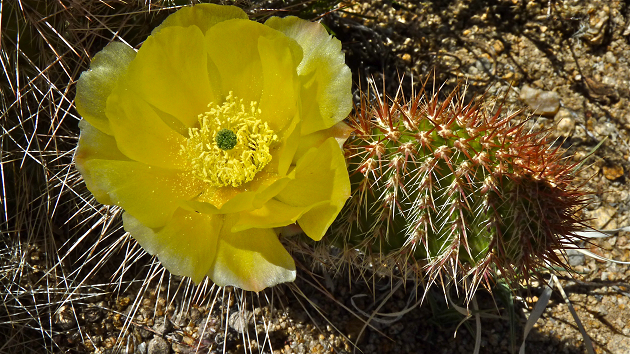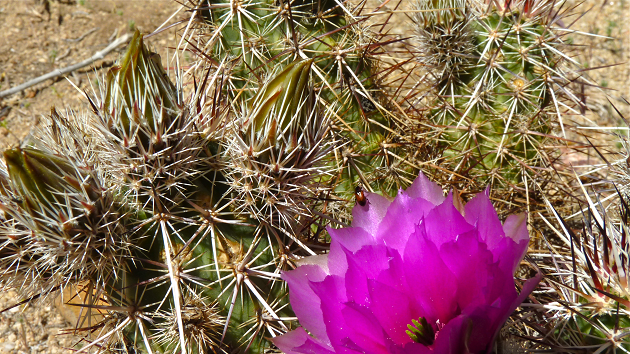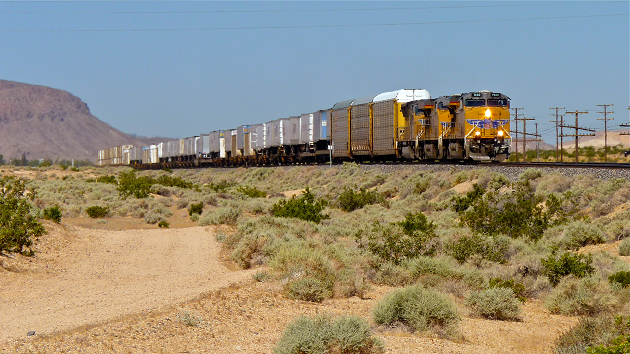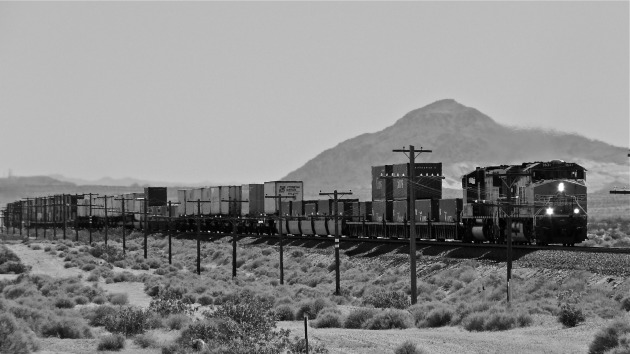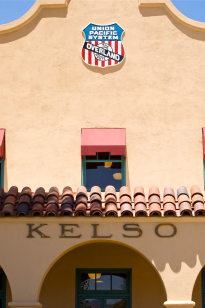The Memorial Day Weekend Mega Tour - Part 4
(Continued from: The Memorial Day Weekend Mega Tour - Part 3)
You have to admit that I gave the Cima Subdivision a good effort. I just wasn’t having any luck. Sometimes the railfan gods just don’t smile upon you. That’s what a backup plan is for. Mine was to head south into Amboy and my home away from home, BNSF’s Needles Subdivision.
I made my way back down that arduous road that I had just traveled down a mere two hours ago and reached the pavement of the Kelso Cima Road once more. I kept an eye on the signals and trackage in case my luck would change as I motored south towards the Kelso depot and Kelbaker Road. My thought was that now that I was committed to leaving the Cima Subdivision the railfan gods would throw me a bone.
Well, they did and then showed me who was boss again. As I reached the Kelso depot I saw the nearly forgotten vision of a headlight on the horizon. Could it be? I jumped out of my rig and positioned myself near the grade crossing on Kelbaker Road so I could spy the signal indications. “Sure enough, one’s coming,” I exclaimed to myself in an embarrassing sort of way. Jeez, I felt like a foamer!
As she neared, I framed the shot. The train was back-lit so I would get the best shot when she passed me and blew by the depot. I leveled the tripod and fussed with settings as I hurried to get “the shot.”
“Damn she’s not going very fast,” I noted. Well that was good for me as it gave me time to reposition for a better shot. OK, now I am ready. Looking over my shoulder, I was filled with disappointment once again. She came to a stop, well short of the depot and my location. “Shit!” Now I felt like I was being toyed with.
Here is the only shot of the train, any train, that I was able to capture while on the Cima Subdivision inside the Mojave National Preserve boundaries for a total 7 hours or so:
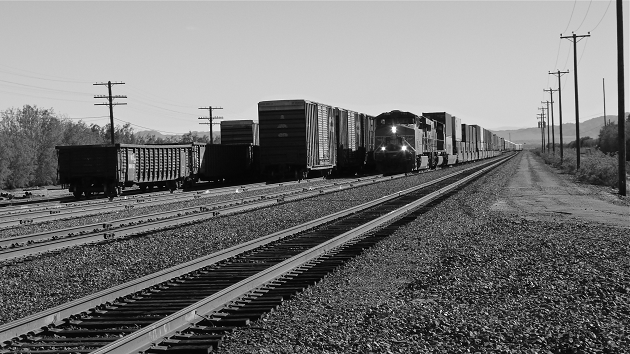 UP 7785 East at Kelso, CA - UP 7785 (GE C45ACCTE) slows to stop at Kelso, CA with an eastbound intermodal train. In a rare scene these days of distributed power, the train will wait here for a helper locomotive to assist with it’s assault of the Cima grade. [5/29/2010 - Cima Subdivision]I bid farwell to Kelso, the Cima Subdivision, and the Mojave National Preserve as I bolted south on Kelbaker Road towards Interstate 40. I smiled at my huge misfortune thus far as I cranked up the tunes and rolled the windows down.
UP 7785 East at Kelso, CA - UP 7785 (GE C45ACCTE) slows to stop at Kelso, CA with an eastbound intermodal train. In a rare scene these days of distributed power, the train will wait here for a helper locomotive to assist with it’s assault of the Cima grade. [5/29/2010 - Cima Subdivision]I bid farwell to Kelso, the Cima Subdivision, and the Mojave National Preserve as I bolted south on Kelbaker Road towards Interstate 40. I smiled at my huge misfortune thus far as I cranked up the tunes and rolled the windows down.
As I made my hand into an airplane and held it out the window in a flying gesture, as all boys do, I thought of the goodness that the Needles Subdivision would bring. I smiled and laughed aloud. Things were looking up already.
I passed Interstate 40 and continued south on Kelbaker Road at a decent clip. I could sense the light would soon be low in the sky, one of my favorite times to shoot photographs. As I crested the the top of the last grade that leads down to the National Trails Highway, I saw no less than three trains off in the distance! Salvation at last!
I eventually reached the grade crossing at Amboy in time to catch an eastbound that had just cleared Bagdad. I hurried across the crossing on foot and set-up for the shot. I felt the rush of being “back in the action” as she scooted by at track speed.
I suspect that most photographers will agree that when you are shooting you are focused on getting the shot and not necessarily the subject of the shot. After this train went by and I reviewed the shots I realized that she was a beauty - an even-numbered lead unit an sporting an American flag to boot. The BNSF’s Needles Subdivision welcomed me in a huge way, and I think I earned it:
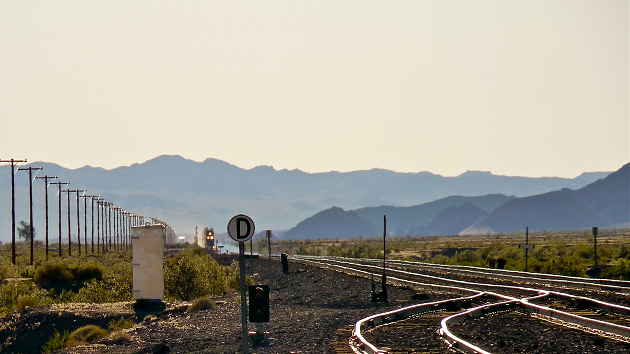 Distant Thunder - As the sun begins sinks low into the sky, BNSF 7200 (GE ES44DC) is fully in charge of this eastbound stack train as she nears Amboy, CA. [5/29/2010 - Needles Subdivision]
Distant Thunder - As the sun begins sinks low into the sky, BNSF 7200 (GE ES44DC) is fully in charge of this eastbound stack train as she nears Amboy, CA. [5/29/2010 - Needles Subdivision]
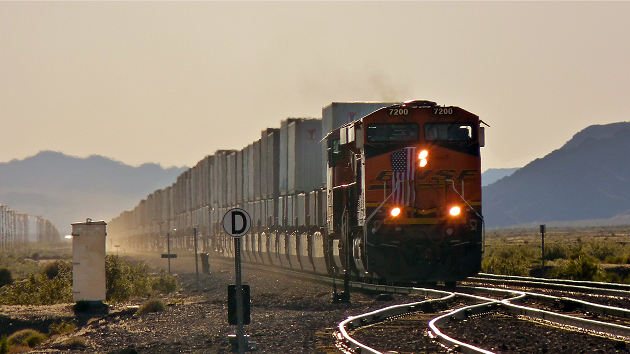 BNSF 7200 East - Late in the day, BNSF 7200 (GE ES44DC) and her intermodal charge kicks up dust as she proceeds east at track speed (70 MPH) through Amboy, CA. [5/29/2010 - Needles Subdivision]
BNSF 7200 East - Late in the day, BNSF 7200 (GE ES44DC) and her intermodal charge kicks up dust as she proceeds east at track speed (70 MPH) through Amboy, CA. [5/29/2010 - Needles Subdivision]
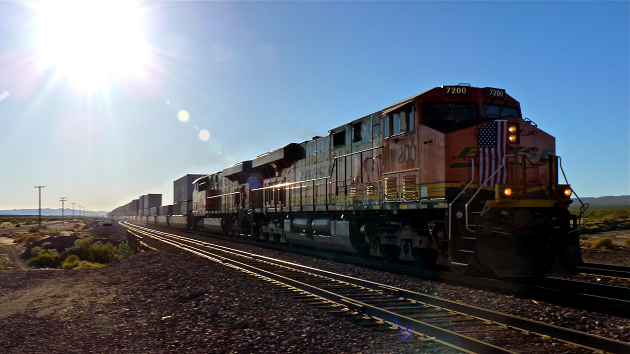 A Patriotic Tribute - As the suns backlights the scene, the crew of BNSF 7200 (GE ES44DC) East has apparently adorned the nose of the locomotive with a US flag as a tribute to Memorial Day, seen here blowing through Amboy, CA. [5/29/2010 - Needles Subdivision]
A Patriotic Tribute - As the suns backlights the scene, the crew of BNSF 7200 (GE ES44DC) East has apparently adorned the nose of the locomotive with a US flag as a tribute to Memorial Day, seen here blowing through Amboy, CA. [5/29/2010 - Needles Subdivision]
I stayed throughout sunset in the area just west of Amboy and took as many shots as I could:
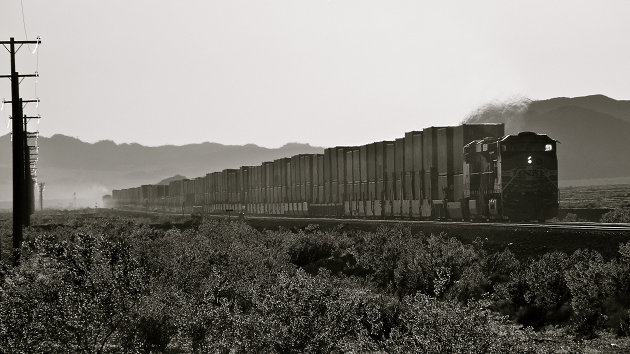 BNSF 6621 West 3 - BNSF 6621 (GE ES44DC), BNSF 5048 (GE DASH9-44CW), and BNSF 5068 (GE DASH9-44CW) lead this westbound intermodal by Amboy, CA with two distibuted power units on the rear. [5/29/2010 - Needles Subdivision]
BNSF 6621 West 3 - BNSF 6621 (GE ES44DC), BNSF 5048 (GE DASH9-44CW), and BNSF 5068 (GE DASH9-44CW) lead this westbound intermodal by Amboy, CA with two distibuted power units on the rear. [5/29/2010 - Needles Subdivision]
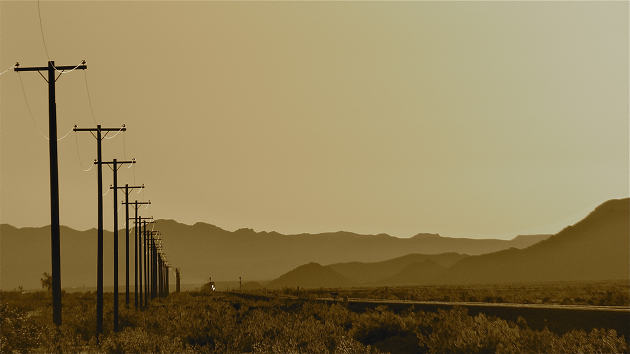 BNSF 7433 East - BNSF 7433 (GE ES44DC) is on the point of this eastbound intermodal approaching Amboy, CA as the sun begins to set. [5/29/2010 - Needles Subdivision
BNSF 7433 East - BNSF 7433 (GE ES44DC) is on the point of this eastbound intermodal approaching Amboy, CA as the sun begins to set. [5/29/2010 - Needles Subdivision
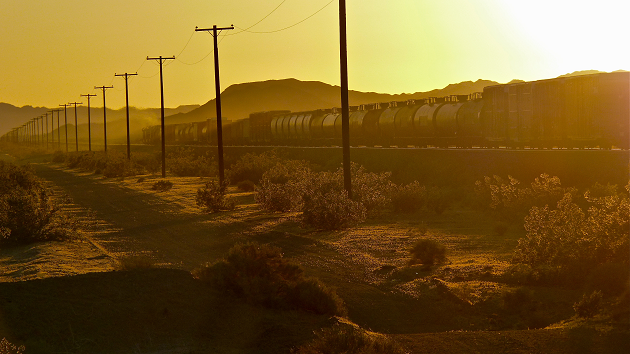 Sunset Desert Railroading - In the golden hours of twilight, the sun traces the shape of this westbound manifest train as she heads west towards Barstow, CA after passing an eastbound intermodal at Amboy, CA. [5/29/2010 - Needles Subdivision]
Sunset Desert Railroading - In the golden hours of twilight, the sun traces the shape of this westbound manifest train as she heads west towards Barstow, CA after passing an eastbound intermodal at Amboy, CA. [5/29/2010 - Needles Subdivision]
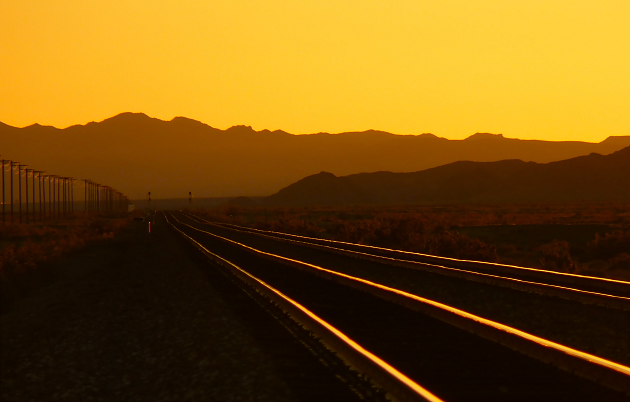 The Calm - A lull in traffic complements the sunset nicely near Amboy, CA. [5/29/2010 - Needles Subdivision]At this point I received a call from Deb saying that she was off to Las Vegas as a treat for her Mom. Although I was already in the Ludlow region seeking a good spot to camp for the night, I decided to head home to dog sit will Deb was gone.
The Calm - A lull in traffic complements the sunset nicely near Amboy, CA. [5/29/2010 - Needles Subdivision]At this point I received a call from Deb saying that she was off to Las Vegas as a treat for her Mom. Although I was already in the Ludlow region seeking a good spot to camp for the night, I decided to head home to dog sit will Deb was gone.
So I left the Needles Subdivision as well and got home around 10:00 PM, a mere 19 hours after I had left and I had driven many, many miles. I was tired and had been intensely challenged yet I feel that captured some great scenes. Nonetheless, I had a great time.
By the way, there are still two days left in the weekend…and the Mega Tour…

 Joe Perry
Joe Perry